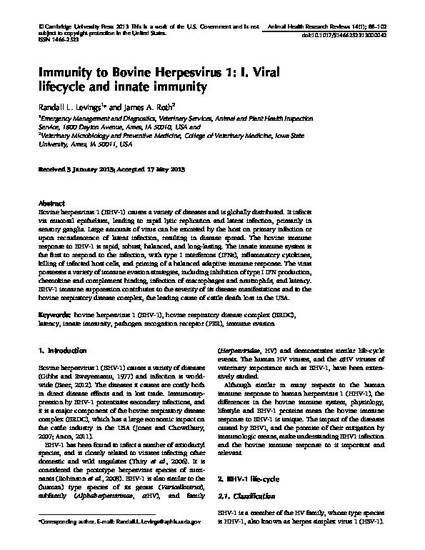
Article
Immunity to Bovine Herpesvirus 1: I. Viral lifecycle and innate immunity
Animal Health Research Reviews
Document Type
Article
Disciplines
Publication Version
Published Version
Publication Date
6-1-2013
DOI
10.1017/S1466252313000042
Abstract
Bovine herpesvirus 1 (BHV-1) causes a variety of diseases and is globally distributed. It infects via mucosal epithelium, leading to rapid lytic replication and latent infection, primarily in sensory ganglia. Large amounts of virus can be excreted by the host on primary infection or upon recrudescence of latent infection, resulting in disease spread. The bovine immune response to BHV-1 is rapid, robust, balanced, and long-lasting. The innate immune system is the first to respond to the infection, with type I interferons (IFNs), inflammatory cytokines, killing of infected host cells, and priming of a balanced adaptive immune response. The virus possesses a variety of immune evasion strategies, including inhibition of type I IFN production, chemokine and complement binding, infection of macrophages and neutrophils, and latency. BHV-1 immune suppression contributes to the severity of its disease manifestations and to the bovine respiratory disease complex, the leading cause of cattle death loss in the USA.
Rights
Works produced by employees of the U.S. Government as part of their official duties are not copyrighted within the U.S. The content of this document is not copyrighted.
Language
en
File Format
application/pdf
Citation Information
Randall L. Levings and James A. Roth. "Immunity to Bovine Herpesvirus 1: I. Viral lifecycle and innate immunity" Animal Health Research Reviews Vol. 14 Iss. 1 (2013) p. 88 - 102 Available at: http://works.bepress.com/james_roth/33/

This article is from Animal Health Research Reviews 14 (2013): 88, doi:10.1017/S1466252313000042.